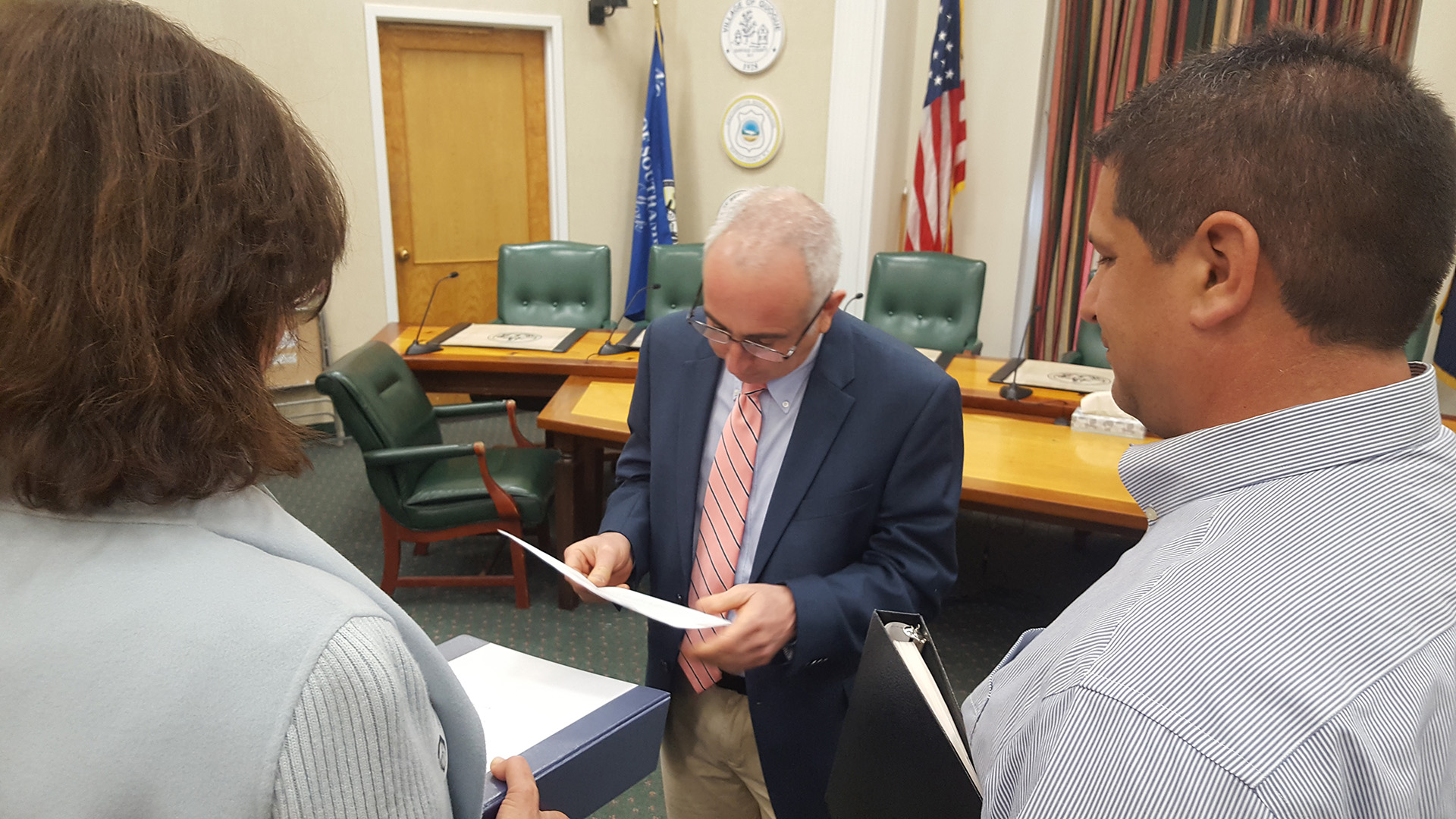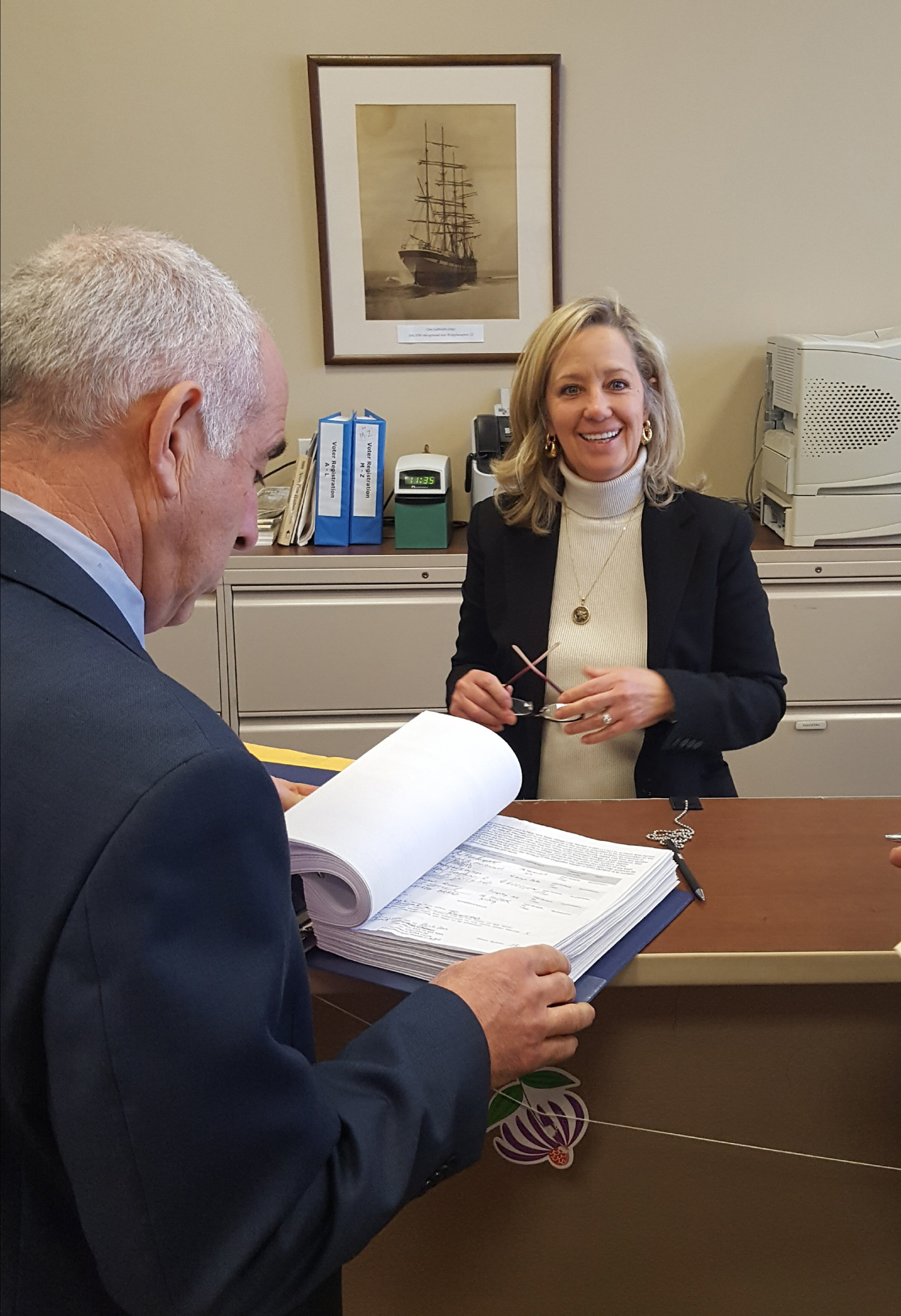East Quogue Group Wants Own Village


Members of the East Quogue Village Exploratory Committee proudly marched into Southampton Town Hall April 3 to present a petition to form their own village. Looking for local control over local decisions, they have more than 780 signatures backing them up.
“We’ve stood up at many meetings and said this is how we feel, and no one’s ever had the ability to ascertain what we wanted,” said committee co-chair Dave Celi. “We feel we have no voice. We feel Southampton Town is not listening. It’s time East Quogue takes its future into its own hands.”
The 15-member group began working together in November 2017, trying to figure out a way to be heard, but found it difficult when there’s no East Quogue representation on the town board, and the hamlet only makes up eight percent of the town’s voting population.
While some may say the rejection of The Hills planned development district and its replacement with the Lewis Road planned residential development is the motive behind the movement, committee co-chair Karen Kooi said while it may have been a catalyst, there were many other issues, such as the Damascus Road landfill contamination that left over 40 homes without drinking water, that have left community members feeling overlooked.
“The town was busy finger pointing over who should take responsibility,” Kooi said of the landfill issue. “And the East Quogue Village is not going to have any say in whether the golf course gets built, whether the village was formed tomorrow or not. The plan is moving forward, and East Quogue has lost all these great community benefits.”
Celi added it comes down to the “kicking of the can.”
“Here we are a year and a few months after the decision was made to kill the PDD, and people in Southampton Town are still kicking the can back and forth to each other getting everyone else involved. Which agency is going to put their finger on it next?” Celi asked. “We’ve been through myriad studies, myriad ups and downs. This is four years in the making and we’re still debating with lawyers. There’s a $100 million lawsuit to worry about. It just doesn’t sound like we have a cohesive political environment in Southampton Town anymore.”
Learning From Sagaponack
The East Quogue Village Exploratory Committee is looking to have its proposed village manage a centralized building, planning, zoning, and code enforcement, but rely on the town for police coverage and public works.
“We want control over land use, construction permits,” Celi said. “When you try to take over everything, it can get very convoluted, and we don’t need to do that. We want good code enforcement and a good building department so we can have quality-of-life issues taken care of.”
The group’s main objective in getting that done was to come up with a thin layer of government at the lowest cost possible. There will be a mayor, trustees, and a local architectural review board made up of volunteers. The only paid position, required by law, will be the village clerk. Kooi said while there have been rumors about wanting to model it after the Village of Quogue, she said the group is actually looking to mirror the Village of Sagaponack, which incorporated in 2005.
“We had booths set up at the post office and local businesses to answer people’s questions, and we tried explaining that we’re not trying to reinvent the wheel,” Kooi said. “Once people understood that, they were eager to sign and eager to learn. We want to protect our community character and the residents here, and we want to do this at the lowest cost possible. Sagaponack has proved it can be done.”
Sagaponack Village Mayor Donald Louchheim agreed.
“In the 13 years since our incorporation, Sagaponack Village has demonstrated that a concerned community can successfully assume control over land use and quality-of-life issues while continuing to rely on the Town of Southampton for essential services without any negative financial impact on taxpayers,” he said in a statement.

A Way To Be Heard
Kooi said delivering the big binder to Supervisor Jay Schneiderman was like “handing off the baby.” Celi said he felt a rush of relief and excitement.
“We’re so proud of what we’ve accomplished and so pleased that we’ve got to this point,” Kooi said. “We decided everything from what the logo could possibly look like, to the plans to get the signatures, to a budget. We planned everything. This group pulled it off.”
The group hired municipal attorney Peter Bee, of the law firm Bee, Ready, Fischbein, Hatter and Donovan, LLP, to guide it on what decisions had to be made.
The proposed village includes the East Quogue School District and the Northern Fire District. This meets the legal requirements for boundary lines with the Village of Quogue to the west, the Flanders/Riverhead School District to the north, and the Hampton Bays School District to the east. Dune Road/the Atlantic Ocean is the southern boundary. Suffolk County voter registration data and Southampton Tax Map data shows 3428 people are regular inhabitants, which means at least 692 signatures were needed.
“The support has been overwhelming,” Celi said. “What was amazing about this group of people in their late 30s to late 70s, of all political persuasions, is that even though we have different backgrounds and didn’t know each other before this, we became quick friends and worked very, very hard to come to a decision on how we could make this work. The goal is to protect East Quogue, and I think we’re going to achieve that.”
Schneiderman is required to publish and post the notice of a public hearing between 20 and 30 days from when the petition was submitted on April 3. The town board is not involved, so the hearing will include Schneiderman, a member of the town’s legal department, and the hamlet residents. It needs to be held in East Quogue.
“It’s my job to review the petition — determine the sufficiency to see if it meets the standards for calling a vote,” Schneiderman said. “Throughout the process, there will be challenges, and my determination could be challenged one way or the other, but I’ll be objective, remain neutral, and make sure that it conforms to the requirements of the law.”
The public hearing must be closed within 20 days of the scheduled meeting, and by 10 days after that, Schneiderman will need to issue a written determination.
“We want locals representing locals,” Celi said. “People who live in our village will be the people we come to. We’d get a better feel for the pulse if it were local. Hopefully there’s a chance for everyone to vote whether or not they want to incorporate.”
After 15 people worked for the last year-and-a-half to move this forward, Kooi said she and many others are no longer skeptical if incorporating can be done, or as to the future of decision-making within the hamlet.
“It’s always the squeaky wheel that gets the oil. The louder you scream, the more you’re heard, while the ones who are quietly going about doing the right thing are usually the ones that are not,” Kooi said. “We’ve found a way where we can be heard.”
desiree@indyeastend.com









